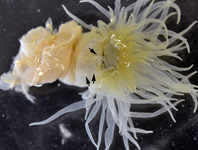Abstract
The world genera of Mycetophagidae are reviewed and four new genera described. Several adult features of Mycetophagidae are discussed, and some newly discovered secondary sexual characters are described and illustrated. A key is given to the adults of all mycetophagid genera. The following new genera and species are proposed: Afrotyphaeola gen. n. (South Africa), A. natalensis sp. n. (South Africa), Neotriphyllus gen. n. (southwestern USA to Central America), Nototriphyllus gen. n. (New Zealand, Madagascar, Chile and Argentina), N. araucania sp. n. (Chile, Argentina), Zeclaviger gen. n. (New Zealand) and Z. explanatus sp. n. (New Zealand). The following synonymies are proposed: Litargus Erichson, 1846 (= Catopius Sharp, 1902) syn. n., Litargus balteatus LeConte, 1856 (= Triphyllus minor Lea, 1895) syn. n., Mycetophagus confusus Horn, 1878 (= Triphyllus perfectus Sharp, 1902) syn. n. The following new combinations are proposed: Litargops intricatus (Blackburn, 1891) (Triphyllus, Litargus) comb. n., L. multiguttatus (Lea, 1895) (Triphyllus, Litargus) comb. n., Litargus irregularis (Sharp) (Catopius) comb. n., Mycetophagus (Paralitargus) didesmus (Say) (Litargus) comb. n., Neotriphyllus confusus (Horn) (Mycetophagus) comb. n. Nototriphyllus aciculatus (Broun, 1880) (Cryptophagus) comb. n., N. adspersus (Broun, 1880) (Cryptophagus) comb. n., N. constans (Broun, 1914) comb. n., N. fuliginosus (Broun, 1880) (Cryptophagus) comb. n., N. hispidellus (Broun, 1880) (Cryptophagus) comb. n., N. integritus (Broun, 1893) comb. n., N. pubescens (Broun, 1909) comb. n., N. madagascariensis (Fairmaire, 1898) (Triphyllus) comb. n., N. punctulatus (Broun, 1880) (Cryptophagus) comb. n., N. rubicundus (Sharp, 1886) (Triphyllus) comb. n., N. serratus (Broun, 1880) (Cryptophagus) comb. n., N. substriatus (Broun, 1880) (Cryptophagus) comb. n. The larva of Nototriphyllus araucania is briefly described and compared with other known myceophagid larvae. The genus Nesolathrus Scott (1922), described in Latridiidae and considered incertae sedis in Mycetophagidae by Lawrence & Newton (1995), is placed in the subfamily Bergininae, following Lawrence & Ślipiński (2013). The tribe Typhaeini Thomson (1863), as delimited by Nikitsky (1993), based on the lateral closure of the mesocoxal cavity by the mesoventrite and metaventrite, is considered to be non-monophyletic. Rhipidonyx adustus Reitter (1876), described in Mycetophagidae, is transferred to Tenebrionidae: Alleculinae, based on the description and examination of a specimen presumed to be the type.

